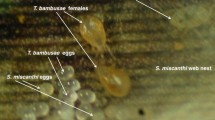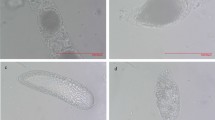Abstract
Three factors were examined to determine their effect on the reproduction and sex-ratio in the predacious miteAmblyseius zaheri Yousef & El-Borolossy in the laboratory. The factors studied included multiple matings, disturbed mating and age of mating females. Fecundity of females mated more than once was 3 times higher than in females mated only once. Artificial curtailment of copulation to 120, 60 and SO min resulted in reduction of fecundity and oviposition period. The Age of mated females has an influence also on fecundity, old females produce fewer eggs compared with young females under constant condition of abundant prey. All 3 factors studied have no influence on the sex-ratio of the progeny.
Similar content being viewed by others
References
Abou-El Ella, G. M., 1998: Studies on certain aspects of some predacious phytoseiid mites. PH. D. thesis Cairo University, 183 pp.
Amano, H.;Chant, D. A., 1978a: Some factors affecting reproduction and sex-ratio in two species of predacious mite,Phytoseiulus persimilis A. H. andAmblyseius andersoni (Chant) (Acarina: Phytoseiidae). Can. J. Zool.56 (7), 1593–1607.
Amano, H.;Chant, D. A., 1978b: Mating behaviour and reproductive mechanisms of two species of predacious mites,Phytoseiulus persimilis A. H. andAmblyseius andersoni (Chant) (Acarina: Phytoseiidae). Acarologia20, 196–213.
Blommers, L.;Van Arendonk, R. C. M., 1979: The profit of senescence in phytoseiid mites. Oecologia (Berlin)44, 87–90.
Castagnoli, M.;Llguori, M., 1991: Laboratory observations on duration of copulation and egg production of three phytoseiid species fed on pollen. Schuster, R. and Murphy, P. W. The Acari: Reproduction, development and life history strategies, symposium, Graz. Austria, 1988. Chapman and Hall 1991: 231–240.
Dosse, G. 1959: Über den Kopulationsvorgang bei Raubmilben aus der GattungTyphlodromus (Acari, Phytoseiidae). Pflanzenschutzbe.22, 125–133.
El-Badry, E.;El-Banhawy, E. M., 1968: Studies on the mating behaviour of the predacious mite,Amblyseius gossipi (Acarina: Phytoseiidae). Entomophaga13, 159–162.
Laing, J. E., 1969: Life history and life table ofTyphlodromus occidentalis. Ann. Entomol. Soc. Am.62 (5), 978–982.
Lee, M. S.;Daris, D. W., 1968: Life history and behavior of the predatory miteTyphlodromus occidentalis. In Utah. Ann. Entomol. Soc. Am.61 (2), 251–255.
Mcmurtry, J. A.;Huffaker, C. B.;Van De Vrie, M., 1970: Ecology of tetranychid mites and their natural enemies: a review 1. Tetranychid enemies: their biological characters and the impact of spry practices - Hilgardia40, 331–339.
Momen, F. M., 1993: Effect of single and multiple copulation on fecundity, longevity and sex-ratio of the predacious mite,Amblyseius barkeri (Hughes) (Acari: Phytoseiidae) (in German). Anz. Schadlingskd. Pflanzenschutz Umweltschutz66 (8), 148–150.
Momen, F.M., 1994: Fertilization and starvation affecting reproduction, inAmblyseius barkeri (Hughes) (Acari: Phytoseiidae). Anz. Schädlingskd. Pflanzenschutz Umweltschutz67 (6), 130–132.
Momen, F. M., 1996: Effect of prey density on reproduction, prey consumption and sex-ratio ofAmblyseius barkeri (Acari: Phytoseiidae). Acarologia,37 (1), 3–6.
Momen, F. M., 1997: Copulation, egg production and sex-ratio inCydnodromella negevi andTyphlodromus athiasae (Acari: Phytoseiidae). Anz. Schädlingskd. Pflanzenschutz Umweltsch.70, 34–36.
Momen, F. M.;El-Saway, S. A., 1993: Biology and feeding behaviour of the predatory miteAmblyseius swirskii. (Acari: Phytoseiidae). Acarologia,34 (3), 199–204.
Overmeer, W.P.T.;Doodeman, M.;Van Zon, A. O., 1982: Copulation and egg production inAmblyseius potentillae andTyphlodromus pyri (Acari: Phytoseiidae). Z. Angew. Entomol.9 (1), 1–11.
Sabelis, M. W., 1985: Reproduction, PP. 73–82. InW. Helle &M. W. Sabelis [eds.], spider mites. Their biology, natural enemies and control, Vol. IB. Elsevier, Amsterdam. The Netherlands.
Schulten, G. G. M.;Van Arendonk, R. C. M.;Russell, V. M.;Roorda, F. A., 1978: Copulation, egg production and sex-ratio inPhytoseiulus persimilis andAmblyseius bibens (Acari: Phytoseiidae). Entomol. Exp. Appl.24 (2), 145–153.
Tsunoda, T., 1994: Mating behavior of the predacious mite,Amblyseius womersleyi Schicha (Acari: Phytoseiidae). Appl. Entomol. Zool.29 (2), 141–147.
Author information
Authors and Affiliations
Rights and permissions
About this article
Cite this article
Saber, S.A., Momen, F.M. Effects of mating factors on reproduction and sex-ratio of the predacious miteamblyseius zaheri yous. & el-bor. (acari, phytoseiidae). J. Pest Science 73, 113–115 (2000). https://doi.org/10.1007/BF02956441
Issue Date:
DOI: https://doi.org/10.1007/BF02956441




